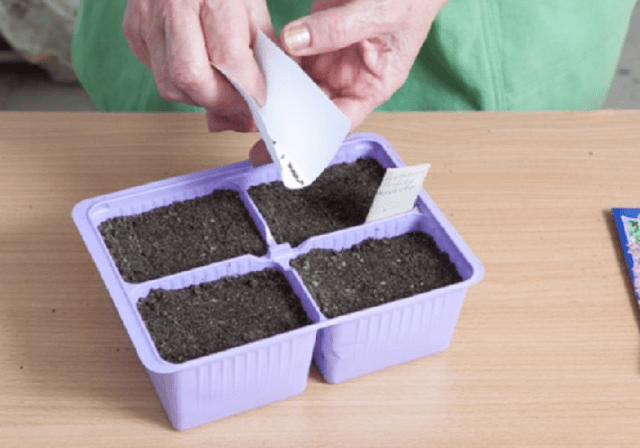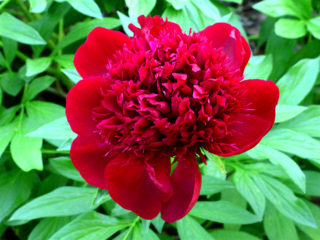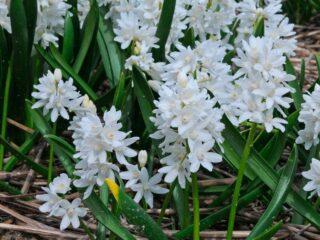Content
- 1 Germination of delphinium seeds
- 2 When to sow delphinium for seedlings in 2022
- 3 What do delphinium seedlings look like?
- 4 Planting delphinium seeds for seedlings in spring
- 5 How long does it take for delphinium seeds to germinate?
- 6 How to care for delphinium seedlings
- 7 When and how to pick delphinium seedlings
- 8 Transplanting delphinium seedlings into open ground
- 9 Why do delphinium seeds not germinate?
- 10 Conclusion
Growing delphinium from seeds involves many nuances, although the process itself is quite simple. It is important to choose the timing and seed correctly, and prepare the soil. Growing requires comprehensive care, proper lighting and temperature.
Germination of delphinium seeds
High germination is only achieved by delphinium seeds that are fresh or stored under the right conditions. Manufacturers usually indicate on the packaging a period of 2-4 years.
Some sources say that the germination of delphinium seeds lasts only 11 months. This actually refers to seed that is stored in paper packaging at room temperature. A sealed aluminum foil bag increases shelf life.
About two centuries ago, an experiment was carried out in the USA by placing delphinium seeds in hermetically sealed vessels at a temperature of -15 °C. Germination was maintained even after 16 years.
When to sow delphinium for seedlings in 2022
It is recommended to base the timing of planting delphinium from seeds on the lunar calendar. Such work with this flower is planned for the second half of February. In 2022, the most favorable period is from the 19th to the 25th.
February 24 and 25 are ideal for sowing if you want to get the earliest possible flowering. On the 14th and 17th, you can start growing annual delphinium from seeds, if you do not plan to then harvest planting material. On February 28, let's sow when you want to get flowers of an unusual color or shape.
In the middle zone, they also begin growing perennial or annual delphinium from seeds in early March. In 2022, the following numbers are recommended for this:
- 2-3;
- 6-8 - only for perennials, if you do not plan to collect seeds from them;
- 11-12.
On the first day of spring, it is worth sowing the seeds if you want to get specimens that are unusual in color and shape.
What do delphinium seedlings look like?
Healthy delphinium seedlings have a dark green color. There should be two cotyledons, which are usually pointed. The optimal height of seedlings when moving to open ground is 10 cm.
After emergence of seedlings, excess seedlings are removed. Only healthy and strong specimens are left for further cultivation.

Too pale or yellowed greens may indicate a lack of light, nutrients, disease
Planting delphinium seeds for seedlings in spring
It is important not only to plant delphinium seedlings in a timely manner, but also competently. It is necessary to choose the right containers for growing, prepare the soil and seeds.
Selection of capacity
At the initial stage of growing delphinium from seeds, choose a low container, but not less than 11-12 cm. There are several options:
- wide drawers;
- cassette;
- plastic pots;
- plastic cups.
Containers that are too large are not suitable. It is not recommended to leave a lot of space for the root system of the flower.
It is good to use peat tablets for growing delphiniums, so as not to disturb them once again by moving them. Seedlings can be planted in open ground right away.
Larger containers are selected for picking seedlings. The optimal volume is 250-300 ml.
The selected container must have drainage holes. Before filling with soil, containers are thoroughly washed and disinfected.
Soil preparation
Soil for growing delphinium can be purchased or prepared independently. The options are:
- store-bought light soil mixture for seedlings;
- soil for succulents;
- self-harvesting - garden soil, humus (compost) and peat in equal parts and coarse washed sand (1/6 of the total volume).
If the mixture is greasy, add vegetable compost (chopped). An alternative is ground straw. The additive must be dry.
The soil selected or mixed independently is sieved. Prevention of fungal diseases is important. For this purpose, the soil is steamed for an hour in a water bath. At the same time, this destroys weed seeds. Alternative options for antifungal treatment are the drug Fitosporin-M or a solution of potassium permanganate.

When growing several varieties of delphinium, you should mark the crops - this will help check compliance with the characteristics
Seed selection
To propagate delphinium by seeds at home, it is important to choose planting material wisely. If you buy it, then only from trusted manufacturers and in a specialized store. Be sure to pay attention to the following points:
- expiration date – the date of preparation and packaging is often indicated on the packaging, the first indicator is more important;
- availability of information on the package - name of the variety, basic characteristics, name of the manufacturer, his contacts, expiration date, general recommendations for planting and growing;
- packaging integrity;
- dryness of the bag, absence of vague spots indicating wetness.
You can prepare delphinium seeds for further cultivation yourself. This is done when the boxes dry out and turn brown. For harvesting, choose a day without precipitation. The seeds are dried in a warm place, dried, debris is removed and stored. You can use paper bags or airtight glass containers. For storage before growing, you need a cool place.
Stratification of delphinium seeds at home
To properly plant delphinium seeds for seedlings, you need to properly prepare them. The algorithm is like this:
- Soaking in a solution of potassium permanganate of a deep pink color. Place the seeds in gauze for 20 minutes.
- Rinse in cold running water.
- Soaking in a growth stimulator. The drug Epin is effective - add a couple of drops to 0.1 liters of water. Exposure time 24 hours.
- Dry the seeds by spreading them on a paper napkin. Without this, they may stick together when sowing.
Sowing rules
When sowing, it is important to know at what depth to plant delphinium seeds and other nuances. You should proceed like this:
- Fill the selected containers with treated soil, leaving 1-2 cm to the edge.
- Level the surface.
- Water the soil with warm water (be sure to settle).
- Distribute the seeds evenly over the surface, slightly deepening.
- Sprinkle the crops with a thin layer of soil - 3 mm is enough.
- Lightly compact the soil.
- Moisten the crops using a spray bottle with the finest spray nozzle. It is better to use boiled water.
- Cover the seedling containers with black film.
Before planting the seeds, the surface of the soil can be thinly sprinkled with fine river sand from a strainer. This allows for better distribution of planting material.
Light deepening, sprinkling with soil and compacting it are only necessary to ensure that the seeds do not float up during the first watering. Otherwise, their distribution throughout the seedling container will no longer be uniform.
Under cover, you only need to germinate delphinium seeds for seedlings at home. Daily ventilation and removal of condensation is mandatory. After the emergence of seedlings, the film is removed for further cultivation.

Delphinium seeds can be scattered over the surface from a piece of paper or distributed with tweezers if there are only a few of them
How long does it take for delphinium seeds to germinate?
Delphinium seeds germinate in about 1-1.5 weeks. The process may take much longer. It all depends on the quality of the planting material, the conditions of its storage, sowing and germination.
How to care for delphinium seedlings
Before emergence, delphinium care consists mainly of daily ventilation.Be sure to control soil moisture.
Temperature
Before emergence of seedlings, it is recommended to provide a temperature of 10-15 °C for 3-4 days. Afterwards, it is useful to keep the crops cool for 1.5-2 weeks. A refrigerator, a glassed-in loggia, a veranda will do. Temperatures up to -2-5 °C are acceptable. Such conditions provide stratification.
When the shoots appear, a regime of 15-18 °C is required for further cultivation. Temperature increases above 20 °C are unacceptable. After the pick, they adhere to the same regime.
Lighting
Darkness is optimal for the germination of delphinium seeds, which is why the crops are covered with black film. When shoots appear, the container is moved to a bright place. If it is on a window, it is better to be closer to the glass.
Watering
Before seedlings emerge, when ventilating the crops, check the soil moisture. If necessary, it is sprayed with a spray bottle.
After emergence, the plantings are moistened as needed. The frequency of watering is based on the condition of the soil. It should be moderately moisturized. Flooding or drying out the soil when growing delphinium is unacceptable.
Water is applied exclusively at the root. While the sprouts are small and tender, it is convenient to use a syringe without a needle for this. A good alternative is watering from a tray.

If, when watering, the water pressure is too high for the seedlings, they will die and may not recover.
Loosening
When growing delphinium, be sure to monitor the looseness of the soil. Handle it carefully so as not to damage the delicate seedlings.
How to feed delphinium seedlings
To strengthen delphinium seedlings, it is necessary to feed them. Use mineral fertilizers with nitrogen, potassium, phosphorus and microelements.It is simple and effective to feed the delphinium with ready-made compounds:
- Agricola;
- Mortar;
- Fertika Lux.
Use ready-made liquid fertilizer or prepare a solution according to the instructions. If fertilizer accidentally gets on the leaves, it is immediately washed off with clean water.
When and how to pick delphinium seedlings
Delphinium picking is carried out in the phase of 2-3 true leaves. Use the same soil mixture as when sowing seeds. For 5 liters of soil add 1 tbsp. l. complex mineral fertilizer (the presence of nitrogen, potassium, phosphorus, microelements is required).
Containers for picking are chosen larger than they were originally. Be sure to wash and disinfect containers and take care of drainage.
It is convenient to use a small spatula for picking. They work like this:
- Fill new containers with soil mixture sifted and treated with steam or fungicide.
- Make a hole of suitable size in the ground.
- Carefully dig up the seedling and move it to a new place. The roots should fit freely.
- Cover the hole with soil.
- Lightly compact.
Picked seedlings are buried in the ground to the point where true leaves grow.

It is better to plant delphiniums in peat pots so that when moving them to the garden you do not further injure the plants.
Transplanting delphinium seedlings into open ground
Hardened delphiniums are transferred to open ground from late April to early summer. The exact timing depends on the climate in the region and the weather forecast for the current year. It is better to choose the time when the spring frosts are over. If they come back for a short time, it's okay. Healthy seedlings are quite cold-resistant.
Before transplanting delphinium into the ground, it is important to choose the right place for its further cultivation. The main points are:
- good lighting during the day;
- light shade at midday;
- distance from bushes and trees;
- wind protection;
- no moisture stagnation;
- fertile and loose soil;
- good drainage;
- Loam or sandy loam is optimal.
It is especially important to choose the right site for seedlings when planting perennial delphinium in the spring. It can grow in one place for up to eight years.
The selected area is dug up and cleared of weeds. The soil for filling the holes is mixed with fertilizers;
- humus - 0.5 buckets;
- wood ash – 1 cup;
- mineral complex (presence of nitrogen, potassium, phosphorus is required) – 2 tbsp. l.
If the soil is acidic, add 50 g of lime per 1 m². Sandy soil is optimized by adding peat. In clay soil, drainage from crushed stone is organized.
The delphinium is transplanted into open ground as follows:
- Make indentations with a side of 40 cm in the prepared area. The distance between the holes is oriented to the height of a particular variety - usually 0.6-0.7 m is left.
- Carefully remove the seedling along with the earthen lump.
- Place the plant in the hole so that the roots are free.
- Sprinkle with soil.
- Compact carefully. The root collar should remain flush with the surface.
Immediately after planting, the delphinium is watered. The first days of cultivation in open ground require shading. This allows the flower to quickly adapt to new conditions.

Proper cultivation of delphinium from seeds will ensure the first flowering by the end of August or beginning of autumn
Hardening
This procedure during the cultivation of delphinium allows it to quickly adapt to outdoor conditions. Hardening begins no earlier than the phase of 3-4 true leaves. The seedlings are taken out into fresh air, gradually increasing the time spent in it. Hardening is carried out for at least two weeks before planting in open ground.
Why do delphinium seeds not germinate?
Often, the lack of seedlings when growing delphinium from seeds is due to improper storage of planting material. If it is purchased, it is better to immediately put it away directly in the packaging in the refrigerator or other cool place. Dryness and heat lead to rapid loss of germination.
Another problem is the shelf life. Be sure to pay attention to it when purchasing. Self-collected seeds are usually sown fresh, while purchased seeds have often been stored for 1-2 years. Over time, the germination of planting material decreases, and improper storage significantly accelerates this process.
Delphiniums may not germinate due to incorrect temperature conditions. If they are not afraid of cold down to -2-5 °C during cultivation, then heat above 20 °C is detrimental to seedlings. Their oppression and death occur.
Another reason for the lack of seedlings is that the seeds are deeply buried. When sowing, they are only lightly sprinkled with soil. If the depth is not so deep, then shoots will still appear, just later. You can help them by carefully sweeping away the top layer of soil with your finger.
Conclusion
Growing delphinium from seeds requires proper preparation of the soil, planting material, and seedling containers. It is important to remember about cleanliness and disease prevention.When growing delphinium, it is necessary to provide a certain temperature, lighting and comprehensive care.








